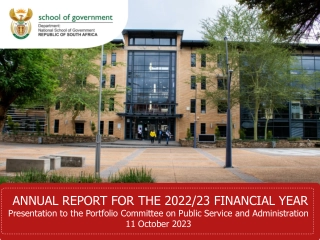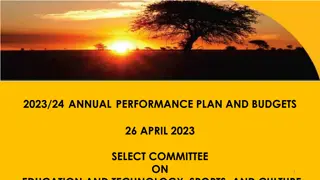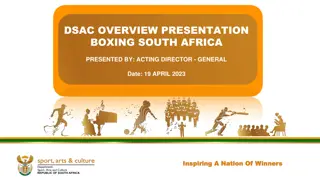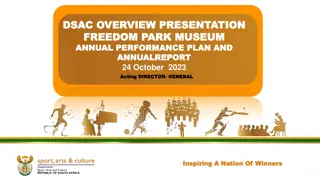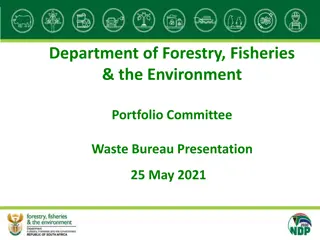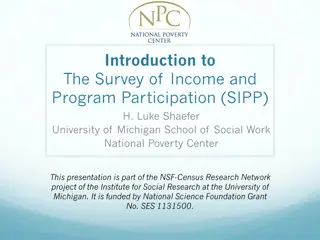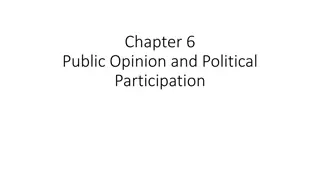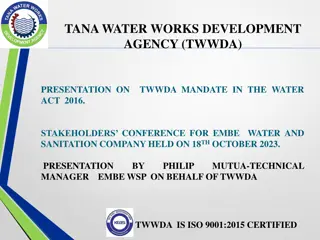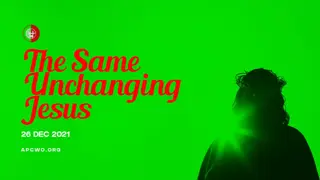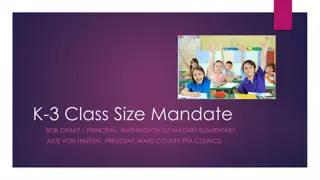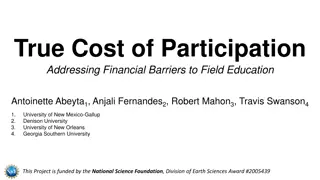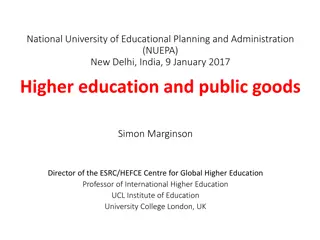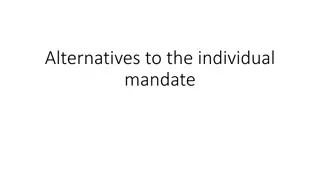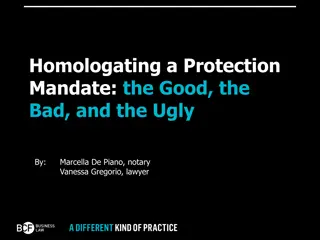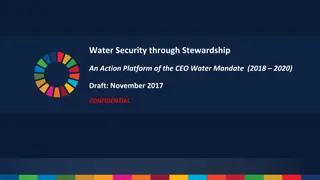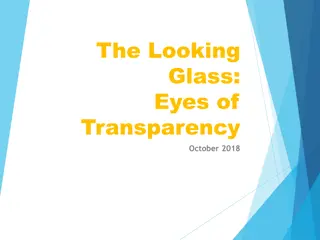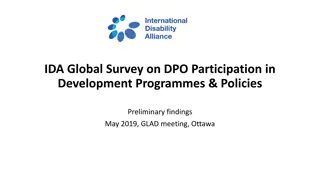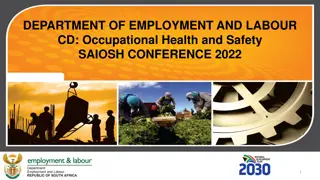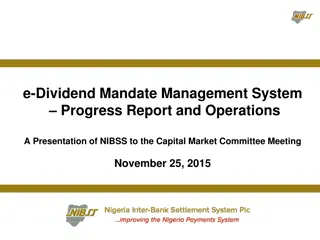Public Participation Mandate: Overview and Importance
Public participation plays a crucial role in legislative processes and governance, empowering communities to engage, provide feedback, and influence decisions. This mandate outlines the significance of public involvement, its key components, and the legal framework supporting it.
Download Presentation

Please find below an Image/Link to download the presentation.
The content on the website is provided AS IS for your information and personal use only. It may not be sold, licensed, or shared on other websites without obtaining consent from the author.If you encounter any issues during the download, it is possible that the publisher has removed the file from their server.
You are allowed to download the files provided on this website for personal or commercial use, subject to the condition that they are used lawfully. All files are the property of their respective owners.
The content on the website is provided AS IS for your information and personal use only. It may not be sold, licensed, or shared on other websites without obtaining consent from the author.
E N D
Presentation Transcript
PUBLIC PARTICIPATION MANDATE INDUCTION TO 7THADMINISTRATION MEMBERS 28 JUNE 2024
PRESENTATION OUTLINE Introduction What is public participation Why public participation Public Participation approach in the Sector Levels of public participation Public Participation Mechanism Mobilisation process Public Petitions Escalation Process Key stakeholder Conclusion 7TH LEGISLATURE MEMBERS ORIENTATION 2
INTRODUCTION Derives its mandates of oversight, law making,public In carrying-out is work, the Legislature ensures adherence to: participation and co-operative governance from the Constitution Constitution of the Republic of South Africa of the Republic of South Africa The Gauteng Provincial Legislature: It is one the three arms of state Standing Rules of the Legislature, and; and co-exist with the other arms All other relevant law of the Republic of South Africa i.e. the Executive & Judiciary within the doctrine of the Separation of powers 3
LEGISLATURE MANDATE The Legislature derives its mandates from the Constitution, Section 104-124 of the Republic of South Africa Law Making Public Participation Scrutiny & Oversight Cooperative Governances
WHAT IS PUBLIC PARTICIPATION? Public participation is the involvement of the public or communities in legislative processes, oversight, issues of governance affecting their lives and activities through the committees of the House. In simple terms Public Participation means: Public Involvement Citizen Engagement Community Involvement It is a two-way communication and collaborative problem-solving mechanism aimed at achieving decisions that are more acceptable. Stakeholder Management
WHY PUBLIC PARTICIPATION? (LEGAL FRAMEWORK & PURPOSE) To enable the People of Gauteng to participate meaningfully in the Committee oversight processes To empower the people of Gauteng to exercise their constitutional rights & obligations To promote public awareness & knowledge about the GPL and governance processes in South Africa. Obtain information about the experiences of the people with regard to service delivery and government action so that relevant institutions can take the necessary action to bring about change. Obtain the views of the public on policy, legislation and other processes in order to enrich the decision-making processes of public institutions. Impart knowledge to communities about governance and government matters that affect them so that the pace and relevance of service delivery is improved. Legal Framework: The Constitution of the Republic of South Africa, 1996, section 118. Public access to and involvement in provincial legislatures. (1), provides that: A provincial legislature must- (a)facilitate public involvement in the legislative and other processes of the legislature and its committees, and (b)conduct its business in an open manner, and hold its sittings, and those of its committees, in public, but reasonable measures may be taken (i)to regulate public access, including access of the media to the legislature and its committees.
PUBLIC PARTICIPATION APPROACH IN THE SA LEGISLATIVE SECTOR The South African legislative sector approach provides opportunity for optimal participation through relations between constituencies, communities and/or members of the public with their elected structures. These would guarantee that the views of the public are filtered through the system to the relevant leadership representatives and to provide relevant feedback to the public on the ground. This approach further encourages MPs and MPLs to continue with their constituency work, to continuously engage with members of the public as political representatives throughout the parliamentary term and to always provide feedback on issues engaged upon. 7
LEVELS OF PUBLIC PARTICIPATION Level 4: Collaborate (Provide Opportunity for Partnering) The figure below has been adapted by SALS from the Ladder of Participation by Arnstein [1] to reflect a best-fit approach for conducting public participation in the sector. Level 3: Involve (Provide Opportunity for Dialogue & Interaction) The four forms of participation depict each level of public participation as having a corresponding increase in the opportunity for public input to influence or impact the process. Level 2: Consult (Provide Opportunity for Input) Level 1: Inform (Provide Opportunity for access to Information) 8
PUBLIC PARTICIPATION MECHANISMS The same types of public participation implementation mechanisms, avenues and activities are executed across the legislative spectrum are through public hearings, petitions, public education and outreach, constituency offices, as well as committee proceedings and House sittings. Parliament and provincial legislatures have common mechanisms to ensure that the public have the ability to engage in law- making through education, outreach and information dissemination, the ability to propose, comment or criticize in both written (petitions) as well as oral (pre-hearings and hearings). Effective public participation comprises various elements incorporating information, publicity and education, and opportunities for submissions or inputs via various outreach activities and other formal processes. Strategies for eliciting public participation are focused on bringing people on the margins and periphery of society into the direct political process, creating a system of governance that is inclusive, responsive and transparent.
PUBLIC PARTICIPATION MOBILISATION PROCESS 1 Programming Committee issues out a term programme 2 Identify stakeholders as per the topic and Question under debate 3 Mobilise and invite community members interested and affected by debates. 4 Brief and educate stakeholders on house procedures and rules 5 Educate stakeholders (role & mandate of GPL) through networking and briefing sessions. 6 Manage stakeholders for the House 7 Committees include: Governance cluster, Economic cluster and Social transformation cluster. Logistical arrangements for all stakeholders attending the sitting
PUBLIC PARTICIPATION MECHANISMS PUBLIC SECTOR PARLIAMENTS EDUCATION/OUTRE ACH PROGRAMS COMMITTEE PUBLIC HEARINGS LAW MAKING AND OVERSIGHT PUBLIC PARTICIPATION MECHANISMS PETITIONS/SUBMI SSIONS CRC/VOTER EDUCATION BUA LE SECHABA/TAKING PARLIAMENT TO THE PEOPLE (NCOP)
PUBLIC PARTICIPATION MECHANISMS Mechanism Summary Public Submissions A submission, expresses views or opinions on a matter or piece of legislation under consideration by a committee of Parliament. Individuals or group may be invited by committees of Parliament or provincial legislatures to make submissions on certain topics or Bills, and the public is also free to submit petitions to Members and legislatures on service delivery issues related to legislation and non-implementation thereof by the relevant authorities. Public Hearings Pre-public hearings must be convened when the institution seeks to engage with the public on a particular issue or with a specific segment of the public, which may be greatly affected by proposed legislation, legislation that attracts public interest, and as part of the oversight process in order to engage meaningfully. After a pre-public hearing has been conducted, the actual public hearing is then convened. During a public hearing, members of the public can make verbal and or written submissions to Members of the Executive, the aim being to assist them to resolve any problem that falls within the committee s scope of work. The public is invited to share inputs, views and perceptions on government programmes, enabling direct, formal input from interest groups, stakeholders and individuals into the refinement of legislation. The issues or topic of a hearing are mainly dependent on the Bill to be discussed. Post public hearings are held to provide feedback to stakeholders, as well as ensure that the issues are referred to the relevant structures. Feedback is provided either in writing or through meeting platforms. Committee members responsible for relevant public hearings are obliged to attend such a hearing and raise issues affecting their respective constituencies.
SUMMARY OF PUBLIC PARTIPATION MECHANISM cont. Mechanism Approach Petition A petition is a written request, complaint, or representation addressed to the institution by an individual or group after having exhausted other avenues. This can be on service delivery or policy matters. The petitions process is split into the following phases: Consideration, Preliminary Investigation, Referral and Appeal. Taking Parliament to the People The National Council of Provinces (NCOP) periodically sits at a predetermined location to interact with the community on issues of service delivery. This also brings together Members of Cabinet at national and provincial levels and municipal councillors, thus facilitating direct interaction between the public and political leaders from all three spheres of government. The programme is conducted twice yearly during March and November. Taking the legislature to the people Similar to the NCOP initiative, provincial legislatures have initiated a process of Taking Parliament to the People, a process whereby some committee meetings and even formal sittings of a legislature are held in community venues or towns more accessible to the more rural parts of a province. This initiative should be undertaken at least once a year. CRC/Voter Education Voter education is the dissemination of information designed to inform voters about specifics and mechanisms of the voting processes. It involves providing information on who is eligible to vote, where and how to register. Civic responsibility Campaign focused on democracy education and Presiding Officer s outreach programs. The program/campaign aims to promote democracy participatory responsibly on citizens with the objective of promoting voter education and voter empathy Programs under CRC/Voter Education includes voter Education seminars, voter debate (school Debates and Youth Debates), School visits, Roadshows, etc.
SUMMARY OF PUBLIC PARTIPATION MECHANISM cont. Mechanism Approach Sector Parliaments These focus on identified special interest groups by providing them a platform to raise issues they face on a daily basis relative to service delivery and legislative policies. The GPL has identified the 9x following special interest groups: Interfaith Parliament Workers Parliament Children s Parliament Youth Parliament Women s Parliament Senior Citizens Parliament Commercial Sex Workers Parliament Persons with Disabilities Parliament Lesbians, Gays, Bisexual, Transgender, Intersex (LGBTI) Parliament Public participation in committees Committees serve as an extension of the House and are presided over by designated chairpersons. These committees are categorised into portfolio committees and standing committees. The public has access to all sittings of the House as well as standing and portfolio committee meetings. Attendance of meetings by the public informs them about the issues at hand, but they do not participate, unless they are specifically invited to address the committee on specific issues. 14
SUMMARY OF PUBLIC PARTIPATION MECHANISM cont. Mechanism Approach Public Education and Outreach Programmes Education, outreach and information dissemination represent key elements of the sector s commitment to ensure effective public participation, since it is clear that without information, participation is not possible. In conducting public education and awareness programmes, techniques and materials are used for educating the public on their elected representatives and promoting the principle of open and accountable government. These programmes seek to inform the public about the processes and developments within the legislature, and they provide ways in which they can become involved through the various mechanisms. This is facilitated through: Educational workshops; Tours of Parliament and provincial legislatures; School education and information programmes; Public awareness campaigns and workshops; Exhibitions where the institution exhibits and markets its work; and The use of media strategies including broadcasting, print and electronic media. Public participation and oversight Public participation and involvement in the legislative process is crucial during oversight processes and activities. Legislatures must ensure that there is sufficient involvement of the public by publicising scheduled committee meetings. In addition, legislatures must ensure that there is a synopsis of a report that the Committee will be dealing with, for example, the citizens version of the report, and schedule at least one of its meetings to be held in communities to solicit community-based verification. 15
SUMMARY OF PUBLIC PARTIPATION MECHANISM cont. Mechanism Approach Annual Performance Plan The Sector Oversight Model demands the constant enlistment of external information input for independent verification. The annual performance plan stage is more rushed than the budget process, however, this process still demands an effort to obtain as much external input as possible in order to assist the support staff and the committee. The Appropriation Bill / Departmental Vote Once the Appropriation Bill/departmental votes are tabled in the House, the Committee Co-ordinator immediately circulates these to all the contacts on the stakeholder lists. There are two lists. The first is for experts, institutes, academics, and other professionals. The second is for community-based organisations, community-based interest groups, that is, parent-teacher associations, worker s associations, that is, police officer unions, teacher unions, and other similar bodies that are beneficiaries of a particular service. These stakeholders should know that they have approximately 1-2 weeks to make a submission to the Committee Co-ordinator. The Committee Co-ordinator processes and circulates these submissions to all members of the committee and support staff. The committee then requests certain stakeholders to make presentations based on their submission(s). The inputs from external sources are intended to further equip the committee for its engagement with a department. These inputs represent the committee s access to non-official data and perspectives, and where these inputs are substantial, they may even present the committee with an independentverification source against which to measure the official data and information presented by a department. 16
SUMMARY OF PUBLIC PARTIPATION MECHANISM cont. Mechanism Approach Quarterly Reports On quarterly reports, the Sector Oversight Model also demands the constant external information input for independent verification, and demands a concerted effort to obtain as much external input as possible with a view to assist the support staff and the committee at the earliest and intermediate stages of a committee s consideration of progress on a certain priority. It is likely that the most useful information sources for the committee will be those that can provide clarity on the state of implementation of a department s programmes. This may mean, in the case of our example, hearings of parent-teacher groups that can verify that certain measures were taken at their school where the school safety team project is underway. Annual Reports The emphasis at this stage is on the variable outcomes, and the measurable indicators agreed upon for the financial year in question, rendering independent verification crucial to the efficacy of the committee s engagement with the department. Independent sources of information are used to confirm that the department is actually meeting the priorities it set out to satisfy at the start of the financial year in question. The Committee Co-ordinator will ensure the attendance of priority organisations at the hearings. This includes the press, and the bodies listed on the portfolio committee s stakeholder list. The Committee Co-ordinators for the Public Accounts Committee and the relevant portfolio committee for the department present at the hearing will liaise so that the research institutes, professors, experts, and so forth, on the portfolio committee s stakeholder list, are invited to the hearing. Oversight visit work / Focused Intervention Studies External stakeholders will be invited to assist the committee by way of submissions in the selection of a subject for the Focused Intervention Study (FIS). After this step, the committee will likely request certain stakeholders to prepare detailed submissions and to make presentations on the chosen subject. These organisations and experts may also be requested to assist further with the development of questions and attendance on oversight visits as guests of the committee. 17
SUMMARY OF PUBLIC PARTIPATION MECHANISM cont. Mechanism Approach Public participation and law-making A key constitutional imperative is that of facilitating public involvement in the processing of the Bills. The facilitation of public participation and involvement in the legislative processes is central to the mandate of Parliament and legislatures. The constitutional obligations are there to ensure a living democracy in terms of the ways in which citizens perceive that they have the constitutional power to influence law-making. During the law-making process, the public is invited to make submissions on Bills. This write-up has fallen short of listing the process of public participation in law-making. May need to capture key aspect from law-making Module to avoid referring Members to another Module Strategic Budget Review for outer years The Medium-Term Budget Policy Statement (MTBPS) allows a department to anticipate its budgetary allocations for the coming three years. Public participation takes on added importance during the MTBPS stage since it is at this, more than at any other stage in the Budget Cycle Model (BCM) where an impact can be made on the department s budget. All stakeholders should be requested to make submissions, and must be provided more time and opportunities during this stage to make presentations, from community members to community-based organisations and experts. 18
PETITIONS ESCALATION PROCESS The last stage involves closure of the petition and archiving for 5 years as per the National Archives Act and Records Services Act of South Africa (no. 43 of 1996). In the event that the petitioner disputes the contents of the report or a report is still not submitted after the ten (10) days extension, the PSC may decide to convene either an internal or external petitions hearing E S C A L A T I O N Upon receipt of a report sent to the petitioner for a written response within seven (7) working days If a report on the referred petition is not submitted within twenty (20) working days a follow up is made and a further ten (10) days extension is given Referral to the relevant authority (provincial department or municipality) for investigation and reporting within twenty (20) working days Rapporteur is appointed to an adopted petition Tabling at Petitions Standing Committee (PSC) for adoption or rejection Register and allocate a reference number, if the submission meets the requirements of the Petitions Act Conduct preliminary investigation to verify what is lodged, where necessary Petition received acknowledged within two (2) working days upon receipt 19
COMMUNICATIONS TOOLS GPL has developed an Integrated Communications, PPP and Stakeholder Management Strategy aimed at supporting the House and its Committees. All the four mandates of the legislature are supported through provision of media services, social media, event management, branding and marketing, audio visual services, stakeholder administration, internal communications as well as graphics and design. 20
KEY STAKEHOLDERS Internal Stakeholders External Stakeholders Constituencies Media houses Chapter 9 institutions NCOP and National Assembly NGOs Civil society organisations Corporate organisations Government departments (provincial and national) Institutions of higher education Municipalities People of Gauteng (Sectoral groups) Office of the Speaker Presiding Officers Committees including Chairperson of Committees) Office of the Secretary LSB and its Sub-committees Executive Directors and Programmes GSF Labour Unions Whippery Members and Staff of the Legislature (and Chairpersons 21
CONCLUSION The GPL has a constitutional obligation to facilitate public access and involvement in its proceedings. Guided by principle of The People Shall Govern - Towards a People-centered Development! The GPL continues to seek mechanisms to facilitate public involvement in realizing the constitutional requirement. Public participation helps in improving budget accountability and transparency which are essential governance principles and values.


